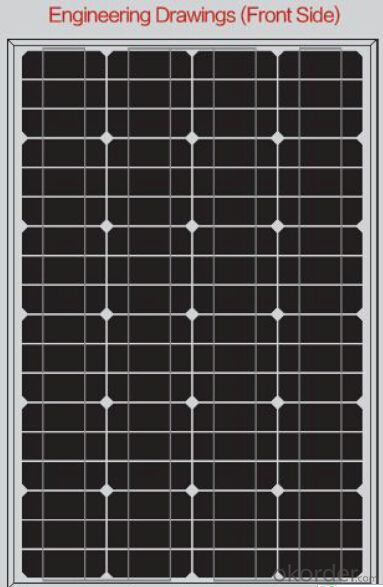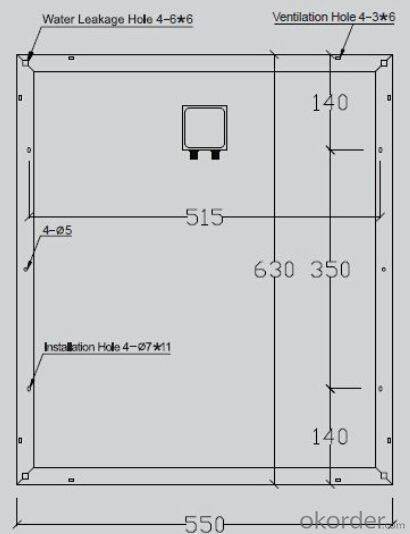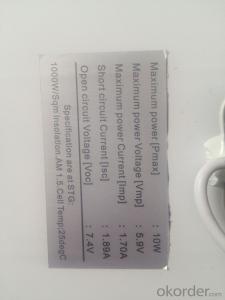Monocrystalline Solar Panels-60W-Apply to solar systems
- Loading Port:
- Shanghai
- Payment Terms:
- TT OR LC
- Min Order Qty:
- 10000 watt
- Supply Capability:
- 50000000 watt/month
OKorder Service Pledge
OKorder Financial Service
You Might Also Like
Product Description
Solar Monocrystalline Series Panels
Introduction of Monocrystalline Solar Panels
CNBM Solar photovoltaic (PV) Panel is designed for large electrical power requirements. It is the optimal choice for both on-grid and off-grid power systems. CNBM Solar panel offers high performance of power per square foot of solar array. Monocrystalline silicon(c-Si): often made using the Czochralski process. Single-crystal wafer cells tend to be expensive, and because they are cut from cylindrical ingots, do not completely cover a square solar cell module without a substantial waste of refined silicon. Hence most c-Si panels have uncovered gaps at the four corners of the cells.
Characteristics of Monocrystalline Solar Panels
I Solar Cell : High efficiency crystalline solar cell. Even if under the weak light, the solar module can produce maximum power output.
II Tempered glass (toughened glass): Anti-reflecting coating and high transmission rate glass increase the power output and mechanical strength of solar module.
III EVA and TPT: Using high quality EVA and TPT to prevent destroying and water.
IV AI frame: Without screw, corner connection. 6 holes on the frame can be installed easily.
V Junction box: Multi function junction box with water proof.
VI Long lifetime: ≥25 years; Less power decrease
VII Good performance of preventing from atrocious weather such as wind and hails.
VIII Resisting moisture and etching effectively, not effected by geology.
Standard Test Conditions of Monocrystalline Solar Panels
The opto-electrical specifications shown below are stabilized values being measured at Standard Test Conditions, Irradiance: 1000W/m2, Spectrum: AM1.5 at 25°C, The info below is subject to manufacturing tolerances. Where appropriate minutes of measurement are available and are used for the dimensioning of the installation.
Advantages of Monocrystalline Solar Panels
1.High reliability with guaranteed -3% to +5% power output tolerance, ensuring return on investment
2. High conversion efficiency based on leading innovative photovoltaic technologies
3. Withstands high wind-pressure and snow load, and extreme temperature variations
4. Attractive appearance Unique frame design, high mechanical strength, and easy Installation
Characteristics of Monocrystalline Solar Panels
Max Power Voltage Vmp (V) | 17.4V | 17.6 V |
Max Power Current Imp (A) | 3.61A | 3.88A |
Open Circuit Voltage Voc (V) | 22.3V | 22.4V |
Short Circuit Current Isc (A) | 3.45A | 3.69A |
Max Power Pm (W) | 60W | 65W |
Temperature Coefficient of Cells
NOCT | 47℃±2℃ |
Temperature Coefficients of Isc (%/℃) | 0.06 |
Temperature Coefficients of Voc (%/℃) | -0.33 |
Temperature Coefficients of Pmp (%/℃) | -0.45 |
Mechanical Data Solar Monocrystalline Series
Power | 60W/65W |
Dimension | 820×550×30mm |
Weight | 5.6 kg |
Tolerance | ±3% |
The dimension of the modules can be changed according to the demand of clients Limits.
Operating Temperature | –45 °C to +80°C |
Storage Temperature | –45 °C to +80°C |
Max System Voltage | 700V |
Guarantee Solar Monocrystalline Series Panels
Products Guarantee | 10 years free from defects in materials and workmanship |
Performance Guarantee | No less than 90% within 10yrs and no less than 80% within 25yrs |
Certificates | IEC, ISO, TUV, CE |
Dimension of Solar Monocrystalline Series Panels


FAQ
We have organized several common questions for our clients,may help you sincerely:
1. What’s price per watt?
A: It’s depends on the quantity, delivery date and payment terms of the order. We can talk further about the detail price issue. Our products is high quality with lower price level.
2. Can you tell me the parameter of your solar panels?
We have different series of cells with different power output, both from c-si to a-si. Please take our specification sheet for your reference.
3. How do you pack your products?
We have rich experience on how to pack the panels to make sure the safety on shipment when it arrives at the destination.
4. What is your warranty system?
Our product performance guarantees for 25 years
• 12 years guarantee for workmanship
• Timeliness of delivery
• Quality Products certified (TÜV, UL, CE, ISO)
5. How do you pack your products?
We have rich experience on how to pack the panels to make sure the safety on shipment when it arrives at the destination.
- Q:How Much energy does Solar Panel Produce,and How long can Solar Panels go without maintenance.
- Solar panels come in many kinds, using a variety of technologies and sizes, but the most common is still the crystalline silicon type. The power produced is variable, but the better ones you can buy approach 20% efficiency, and the peak energy from the sun is 200W/m^2 (Watts per square meter). This only occurs when the panel is lined up with the sun on a clear day with the sun high in the sky. The efficiency is also affected by how the electrical energy is taken from the panel, and the temperature of the panel. In the full sun the temperature approaches 60C, so the voltage drops. The links below provide a lot of information about such matters. A BP panel 50mm x 674mm gives a peak power of 20W. This is .07 square meters. As you can see this is very close to 20%. (The third link). However this is less in practice because the sun may not be full sun and may not be perpendicular to the panel. The output drops as the cosine of the angle to the sun, more or less. Even with peak sun this would produce only about 00W charging a 2V battery directly, unless an electronic Maximum Power Point Tracking (MPPT) charge control is used.
- Q:Can solar panels be installed on a library or educational institution?
- Yes, solar panels can be installed on a library or educational institution. In fact, many libraries and educational institutions have already embraced solar energy and installed solar panels on their rooftops or surrounding areas. This helps them reduce their carbon footprint, save on electricity bills, and serve as a sustainable example for the community.
- Q:What is the difference between Photovoltaic Panels and Solar Panels?
- Both of them are different types of solar panel. EDIT: Misspelling on Jeff's answer below! I think he means 'silicon,' not 'silicone!' Solar cells are typically grown on a glass substrate or put onto glass. Silicon is currently the most common material, followed by CdTe or cadmium telluride. Other materials like CIGS (Copper Indium Gallium (di)Selenide) are breaking into the market. Some people have great hopes for organic or 'dye' solar cells.
- Q:Can solar panels be used for powering a data center?
- Yes, solar panels can be used to power a data center. By harnessing sunlight and converting it into electricity, solar panels can provide a renewable and sustainable source of power for the energy-intensive operations of a data center. However, the feasibility may depend on factors such as the size of the data center, energy requirements, available rooftop or ground space for solar panel installation, and the location's solar energy potential. Additionally, integrating solar power with other energy sources or implementing energy storage systems may be necessary to ensure uninterrupted power supply for the data center's continuous operations.
- Q:Can solar panels be installed on a carport structure?
- Yes, solar panels can be installed on a carport structure. In fact, carports are an ideal location for solar panel installations as they provide ample space and can help maximize the energy production potential. Additionally, solar carports offer the added benefit of providing shade and protection for vehicles while generating clean and renewable energy.
- Q:I want to install a solar panel on my car. I want to know that how much energy can be generated by a panel of size 4 foot by 6 foot. and the cost of installation.
- A little more than 0 watts per square foot, so that size panel would generate 250 watts under ideal conditions, which is noon on a sunny but not too hot day, near the equator. That's about /3 horsepower, or the same power as a man working hard. That is larger than needed to keep the battery of the car charged, unless you plan to run a laptop or something off it at night. The power is also too small to power the car for driving. If it's an electric car, you could get maybe another 2 miles per day out of the car, again, under ideal conditions. An RV store might have an idea of how much installation would cost. They would be accustomed to solar panels for RV's, but probably not small cars. A panel of that size would cost perhaps $500-800 just for the panel.
- Q:Can solar panels be used for charging outdoor power tools?
- Yes, solar panels can be used for charging outdoor power tools. Solar panels generate electricity by converting sunlight into energy, which can be used to charge batteries or power devices like outdoor power tools. This eco-friendly and cost-effective solution provides a sustainable way to charge outdoor power tools without relying on traditional electrical outlets.
- Q:Can solar panels be used in areas with high pollution?
- Yes, solar panels can still be used in areas with high pollution. While pollution can reduce their efficiency to some extent, solar panels can still generate electricity even in polluted areas. However, it is important to note that excessive pollution may result in a decrease in their overall performance and require more frequent maintenance to keep them clean and functioning optimally.
- Q:I need to prepare solar panels for using in home needs electricity purpose. Can anyone could help me to know much more about it.
- The following guide is the best DIY guide to build your own Solar Panels. the guide include step by step instructions + video. To Your self a favor and invest on buying this guide (it will save you a lot of time money) tiny /solar55
- Q:Online stores selling solar photo-voltaic generation kits gives specs indicating the power generation capability of the system. For example, Solar World Grid-Tie Solar Electric System with 245W Panels PV Powered PVP2000 Inverter, .2 to 2.4 kW. This seems to indicate that the system can generate .2 to 2.4 kW. Is that per day? Per month? I'm trying to calculate the return on investment, but can't because I don't know how much power a system such as this will generate in a month.
- There okorder Why pay thousands of dollars for solar energy ($27,000 average cost) when you can build your own solar panel system for just a fraction of the retail cost. You can build a single solar panel or you can build an entire array of panels to power your whole house. Some people are saving 50% on their power bill, some people are reducing their bill to nothing. But what’s most impressive is that just by following these instructions some are even making the power company pay them!
1. Manufacturer Overview |
|
|---|---|
| Location | |
| Year Established | |
| Annual Output Value | |
| Main Markets | |
| Company Certifications | |
2. Manufacturer Certificates |
|
|---|---|
| a) Certification Name | |
| Range | |
| Reference | |
| Validity Period | |
3. Manufacturer Capability |
|
|---|---|
| a)Trade Capacity | |
| Nearest Port | |
| Export Percentage | |
| No.of Employees in Trade Department | |
| Language Spoken: | |
| b)Factory Information | |
| Factory Size: | |
| No. of Production Lines | |
| Contract Manufacturing | |
| Product Price Range | |
Send your message to us
Monocrystalline Solar Panels-60W-Apply to solar systems
- Loading Port:
- Shanghai
- Payment Terms:
- TT OR LC
- Min Order Qty:
- 10000 watt
- Supply Capability:
- 50000000 watt/month
OKorder Service Pledge
OKorder Financial Service
Similar products
New products
Hot products
Hot Searches
Related keywords





























